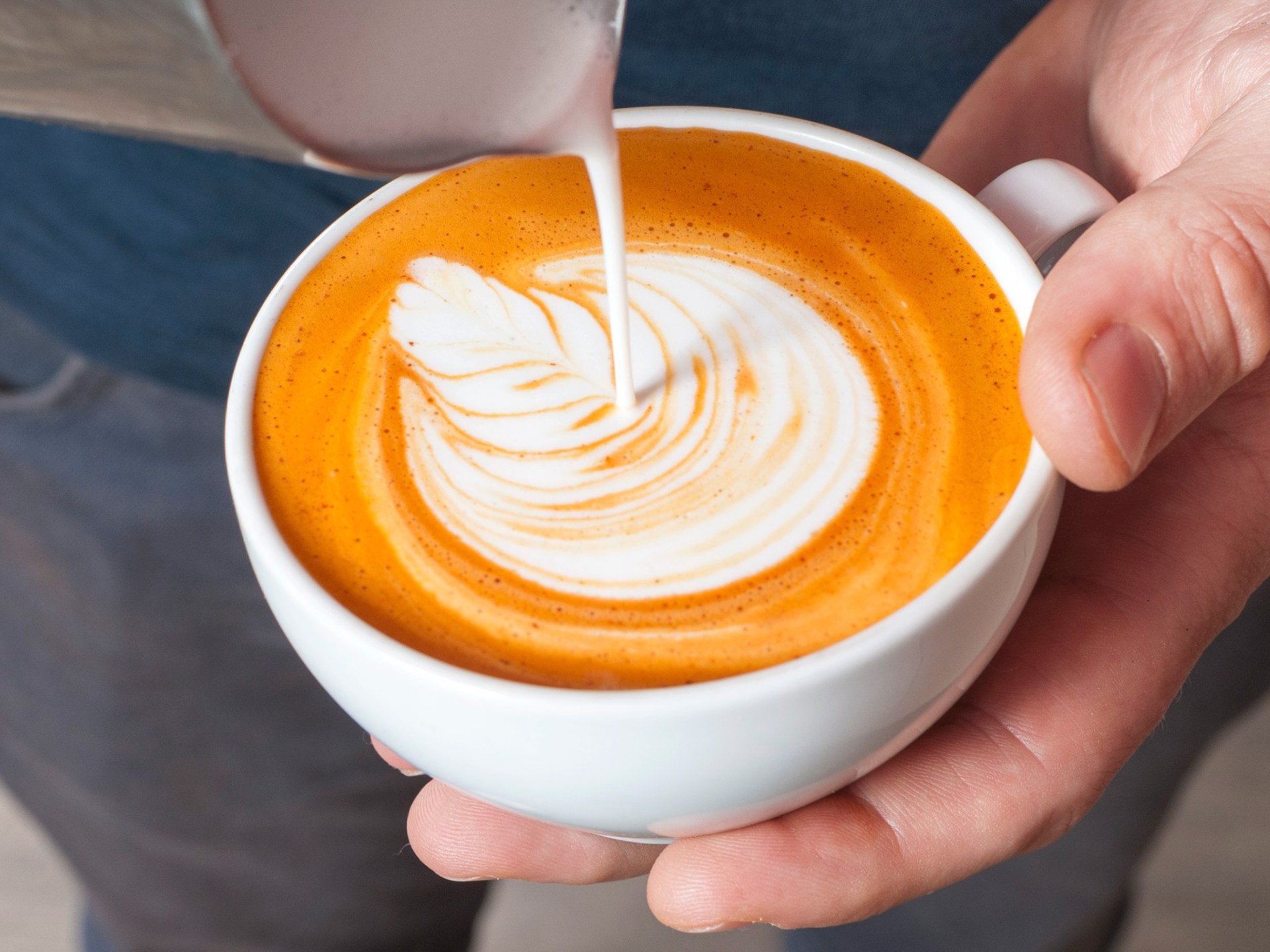On a sun-parched plateau, high in South Africa’s rugged Cederberg mountains, Boltwin Tamboer harvests rooibos tea in much the same way his forefathers would have done. Watched over by a cave adorned with 6,000-year-old depictions of elephants and winged medicine men, he slices through a fistful of the hardy shrub with a deft flick of his sickle before stashing the metre-long (3.3 foot) stems between his legs.
Working in 40-degree heat, he’ll harvest between 300-600 kg (661-1,323 lbs) of wet tea every day for the next two months. Some of this crop will be used as traditional tea. And, thanks to the growth of a newly imagined beverage, some will end up, curiously, in espresso machines.
Tamboer’s San (also known as Bushmen) ancestors were the first to discover the healing properties of the yellow-flowered shrub, which grows only in the Cederberg in the Western Cape, 250 km (155 miles) from Cape Town. The Europeans who arrived in the hostile, drought-prone region in the 18th century cultivated rooibos, or Aspalathus linearis, and brought its red tea to a broader market. Rooibos tea is a South African staple. Every kitchen in the country boasts a box of the soothing brew that’s often given to colicky babies and drunk – with loads of milk and sugar – at church gatherings and PTA meetings.
But rooibos has never been considered an exciting or trendy beverage. Husband and wife team Pete and Monique Ethelston decided to change that while on a life-altering trip. After learning that the humble tea was capable of more depth and flavour and could even be used as a coffee substitute, or a kind of red “espresso”, they began a business that would change the way people saw and experienced rooibos.
![Farmhand Gert harvesting rooibos plants with a sickle in the Cederberg mountains in South Africa. [Courtesy of Red Espresso]](https://www.aljazeera.com/wp-content/uploads/2024/08/red-espresso-Tealands-5-1724007305.jpg?w=770&resize=770%2C513)
In the beginning
Pete and Monique got married “fairly late in life”, they say. Both had established successful careers – Pete as a consultant working for companies like Coca-Cola, and Monique as a brand manager at Unilever and local distilling behemoth Distell. Things veered from the script when Pete convinced his bride to join him on an extended honeymoon to Nepal and Tibet. Awed by their surroundings, they found themselves grappling with some big life questions. “In our corporate lives, we had this nagging feeling that we weren’t doing people or the planet much good,” says Pete.
This existential crisis was answered in a Kathmandu internet cafe when Pete received an email from a long-time friend and business partner (they still own a tree nursery together), Carl Pretorius. The email told how Pretorius, jittery after his sixth coffee of the morning but still keen for more, tore apart a rooibos tea bag and put the leaves through his home espresso machine – and ended up with a tasty coffee alternative.
Over the next few weeks, by experimenting with the exact grind of high-quality rooibos, Pretorius was able to produce something that mimicked real espresso – right down to the frothy “crema” on top – but without the caffeine. Brewing the rooibos like espresso also supersizes the antioxidant kick that rooibos tea is known for. While it may not taste like coffee, when topped with frothed milk and a swirl of honey it has the look and feel of a cappuccino. “Let’s take this to market,” he wrote.
![Rooibos tea [Courtesy of Red Espresso]](https://www.aljazeera.com/wp-content/uploads/2024/08/Red-Espresso-Rooibos-Espresso-1724007243.jpg?w=770&resize=770%2C770)
Pretorius has since exited the venture amicably, but from the first day, Red Espresso (the name they settled on), has been driven by the Ethelstons.
“Their combined skill sets made them perfect for the role,” says Jeremy Sampson, a branding expert with Brand Finance Africa who has studied the Ethelsons’ business approach. “He has the finance and logistics experience, and her marketing pedigree is exceptional,” says Sampson, adding that they’ve effectively applied their business fundamentals in developing the company. “Spreading out into different products and markets, and into white labelling … It’s a classic way of doing things. It’s the Unilever model applied to a family business, and it’s totally sustainable.”
This is not to say that the journey has been easy. Selling any product is hard – but it’s even trickier if people don’t understand what you’re selling. “These days, there’s an appetite for espresso alternatives,” says Sampson. “But I remember doing market research into the international tea industry 20 years ago, and rooibos wasn’t on anyone’s radar. And no one had even heard of a superfood espresso.”
The Ethelstons understood that the only way to convince people that they needed something like Red Cappuccinos in their lives was to get them to actually try them. Instead of trying to break into the retail market, they started knocking on cafe and restaurant doors. Their first big break came in 2006 when leading South African supermarket Woolworths added Red Cappuccinos to their cafe menu. Two decades later, the relationship with Woolworths has grown to include retail and white labelling, with the retailer remaining an important strategic partner.
Based on the success of their signature brew, the business has grown to include other beverages (they now have 100 product lines) and markets – Red Espresso has a footprint in 12 countries. The business, which employs 60 people at its head office in Paarl, a 45-minute drive from Cape Town, provides an income to a further 20 on the tealands.
The business is doubling in size every three years. But the best part, says CEO Pete Ethelston, is that “the growth is coming across the board. In both local and export markets, in both food service and retail industries. And in both our own brand and our private label work for other brands.”
![Pete + Monique Ethelston In The Tealands [Courtesy of Red Espresso]](https://www.aljazeera.com/wp-content/uploads/2024/08/red-espresso-Pete-Monique-Ethelston-In-The-Tealands-1724007226.jpg?w=770&resize=770%2C457)
Putting taste first
“Our marketing strategy has always been about putting taste first,” says Monique. “We’ve now managed to break into the mass retail market … But every product still starts with quality ingredients and superior taste.”
The couple learned early on that high-altitude, hand-harvested rooibos tasted better, and were willing to pay a premium for it. Once they’d settled on their preferred suppliers, they sat down with the farmers and agreed on a pricing structure based on fair-trade principles. “It was all agreed around the braai (barbecue) and sealed with a handshake,” remembers Pete. “Now, twenty years later, we’re good friends.”
Since 2015 the Ethelsons have invested in Seeds of Hope, a community upliftment program for small-scale farmers in a remote corner of the Cederberg. Residents of Heuningvlei – a 25-home Moravian mission town at the end of a long dirt road – can lease land from the church for a small price. “But this isn’t worth much without seedlings, tractors and money,” says Pete. By helping out with these farming necessities, and coaching the small-scale farmers in modern agricultural techniques, they’ve been able to resurrect rooibos farming in a forgotten corner of the country.
![Donkey cart used for transporting the harvested rooibos plants in the Cederberg Mountains in South Africa [Courtesy of Red Espresso]](https://www.aljazeera.com/wp-content/uploads/2024/08/red-espresso-Seeds-of-Hope-Subsistence-Farming-Project-1-1724007188.jpg?w=770&resize=770%2C513)
More farmers have come on board every year, and Red Espresso now buys around 40 tonnes of high-quality rooibos from 20 different subsistence farmers annually – about 20 percent of their annual needs. The remaining 80 percent is purchased from the local farmer who employs Boltwin Tamboer.
One of the first farmers to join the Seeds of Hope project was Barend “Ghal” Ockhuis, who, thanks to the fair-trade prices paid by Red Espresso, has managed to replace his horse-drawn cart with a second-hand Toyota.
Ghal has lived in Heuningvlei all his life and has been farming – beans, rooibos, sheep – since he left school. But “everything has changed,” Ghal says, “since Red Espresso started to give me seedlings and plough my land.”
In exchange for his two tonnes of tea, Ghal receives an annual lump-sum payment – a sum his parents and grandparents could only have dreamed of. “I am a businessman,” says Ockhuis. “I can look after a family.” And he is not alone. For the first time in decades, the opportunity to sell tea to Red Espresso at above-market prices is giving the youth of Heuningvlei a reason not to move to the city for work.

One drink at a time
Before proving there was a market for their product, the company invested heavily (“money we didn’t have,” says Pete) in intellectual property rights, securing worldwide trademarks for names like Red Espresso and Red Cappuccino, and patents for their grind. At Monique’s insistence, they also hired expensive, top-tier designers for their logos and branding. “We’ve always had a big brand feel,” says Pete. “Even when we were a tiny operation running out of our garage.”
Their determination to punch above their weight paid off. In 2008, Red Espresso was voted Best New Product by the Speciality Coffee Association of America. Following this, they received offers from retailers including Whole Foods – but Pete and Monique didn’t feel ready. At the time, they only sold ground tea, which they believed would have been lost in the sea of retail. “No one would have known what to do with it,” laughs Monique.
So, in 2014 they moved ahead, beginning with Nespresso-compatible capsules. In 2017, they launched a range of superfood lattes (turmeric, matcha and beetroot), and now, seven years later, hot chocolate and chai are also major parts of their business.
It’s not easy for a small business to break into mass retail, but Pete says their “point of difference” has always been their gourmet products and innovation. They were the first company to introduce vegan chai and hot chocolate powders in South Africa, for example.
While the company has made significant efforts to advance its own prospects, it has also benefited from the global shift towards health and wellness – expected to be a $7-trillion global industry by 2025. “We used to have a hard time convincing people to try our product,” says Monique. “But we now find consumers and cafes very open to the idea of caffeine-free drinks made from healthier ingredients.”
However, there have been many hurdles – not least the microeconomic challenges of doing business in South Africa. “Loadshedding”, the South African government’s term for scheduled power cuts, and shipping delays caused by crippling backlogs at South African ports have both proved to be a major hassle and expense. All this is compounded by the “challenges facing any brand: to keep on resonating, keep on being relevant, keep on evolving”, says Sampson.
![Ground Red Espresso about to be expressed. [Courtesy of Red Espresso]](https://www.aljazeera.com/wp-content/uploads/2024/08/Red-Espresso-Rooibos-Espresso-2-1724008075.jpg?w=770&resize=770%2C513)
Keeping it in the family
The firm has navigated these challenges to achieve an impressive 30 percent growth each year (though, Pete grumbles, they’ll likely need new premises soon). They’ve managed this while remaining 100 percent family-owned – despite strong interest from established beverage industry players and venture capitalists.
“We always sit and talk with potential investors,” reveals Pete. “But we keep coming back to ‘what would they give us?’ The main thing an investor would bring is acceleration. But if we grew any faster, something would have to give … And I already don’t have a lot of hair. There’s a lot of freedom when it comes to staying in control of your own destiny.”
One reason they’re content to continue independently is their built-in succession plan. While their own children are still in school, Monique’s younger siblings – Nic Reid (with the firm since day one) and Kirsty Reid – and Nic’s wife Joanne all hold key roles in the business.”
There’s also a culture of promoting employees from the factory floor into management roles. For example, Antonio Suse started as a general blender in 2021 and has risen to the position of production supervisor. “I’ve learnt skills which I can use anywhere in the world,” he says. “And I’ve received a huge financial boost … Now I can do more for my daughter.”
Suse is by no means unique: “All of our supervisors started out on the floor,” says Monique, adding that the company’s extremely low staff turnover rate (less than 5 percent annually for the last 10 years) speaks for itself.
Investing so much in people is no easy task. “Going from 30 people to 60 people feels like much more than doubling,” says Monique, who says she spends 80 per cent of her time on HR. But they wouldn’t want it any other way. “Sometimes I pinch myself when I see these huge trucks pull up at our factory,” says Pete. “It’s got bigger than I ever imagined. But the ethos and the culture of our business hasn’t changed a bit.”
He’s referring to their belief that business can benefit both the planet and people, as shown by their gold status on the prestigious SEDEX accreditation, for responsible and ethical business practices within the supply chain – a recognition typically achieved by much larger companies.
Every year Red Espresso plants endangered Clanwilliam cedars near Heuningvlei. And their factory in Paarl was built with the environment in mind. Insulated building blocks and double glazing reduce the need for air conditioning. Massive tanks collect rainwater, which is used for flushing the toilets and scrubbing the floors, and over 70 per cent of their energy needs are met by rooftop solar panels.
![Pete and Monique Ethelston of Red Espresso standing with subsistence farmers and farmhands in rooibos plantations in the Cederberg Mountains in South Africa. [Courtesy of Red Espresso]](https://www.aljazeera.com/wp-content/uploads/2024/08/red-espresso-Seeds-of-Hope-Subsistence-Farming-Project-4-1724007212.jpg?w=770&resize=770%2C513)
While Pete and Monique say they remain fully committed to the business, they are trying to transition away from day-to-day operations. “We love travelling and we really like the people we work with. It would be great to spend more time with key accounts and the farmers, and visiting export markets,” says Monique. “Pete is best at relationships, so he needs to get out there. The real challenge is finding the people to make sure everything runs smoothly back home.”
Pete agrees. “Spending more time on the road dovetails with where we are in our lives. Our kids have almost finished school, so we’re going to be empty-nesting soon. I’ve never been that guy who’s dying to play golf every day,” he laughs. “Work is a massive part of our lives and our marriage, so let’s find the parts we love to do and get stuck in …”
They’re already putting this mindset into action. Recently, Pete took their eldest daughter on a sales trip to Germany and the couple has plans to visit the Middle East soon. They also admit to wanting a week to “switch off from it all” on the tea lands. “Outside of harvest, it is the most magical, relaxing place.”
![The tealands of the Cederberg Mountains in South Africa [Courtesy of Red Espresso]](https://www.aljazeera.com/wp-content/uploads/2024/08/red-espresso-Tealands-_7-1724007262.jpg?w=770&resize=770%2C499)















Leave a Reply